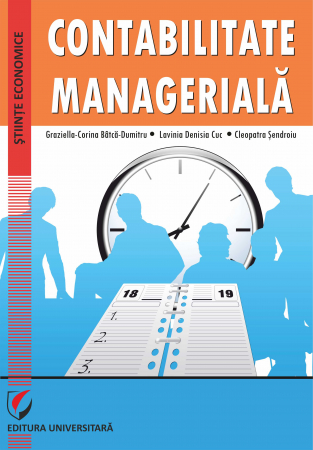Publisher: Editura Universitară
Author: Vadim Dumitrascu
ISBN: 978-606-28-0820-4
DOI: 10.5682/9786062808204
Publisher year: 2018
Edition: I
Pages: 248
- Description
- Authors
- Content
- More details
- Reviews (0)
Introduction / 9
Chapter 1
Price - notion, implications and economic functions / 13
1.1. The economic meanings and functions of price / 13
1.2. The system of factors influencing market prices / 15
1.3. Price system in the market economy / 18
1.4. Generic approaches to price formation / 20
Chapter 2
The role of competition in the economy / 24
2.1. The concept of competition / 24
2.2. Types of competitive market structures / 26
2.3. Market entry barriers / 28
2.4. Disputable markets / 29
2.5. Competition and prices - connections and interdependencies / 31
Chapter 3
The impact of information asymmetries on prices and competition / 36
3.1. Information asymmetries and competition / 36
3.2. Prices and competition from the perspective of signal theory / 37
3.3. Implications of moral hazard on the principal - agent relationship / 39
3.4. Effects of transaction costs
3.5. Effects of agency (mandate) costs / 42
3.6. Economic bases of non-competitive behaviors / 44
Chapter 4
Company pricing strategies / 51
4.1. The objectives of the company's pricing strategy / 51
4.2. Elements of substantiation of the selling price / 52
4.3. Pricing methodology / 55
4.4. Typology of company pricing strategies / 56
4.5. Determining and adjusting the base price (list) / 61
Chapter 5
Pricing techniques / 66
5.1. Details on the interdependencies between costs and prices / 66
5.2. Variable and fixed costs as a basis for pricing / 73
5.3. Profit as a fundamental element of price / 74
5.4. The most common pricing techniques / 77
5.5. Using standard costs in pricing / 80
Chapter 6
Manifestations and effects of imperfect competition / 84
6.1. The emergence of new forms of competition / 84
6.2. Essential changes in the competitive systems of companies / 85
6.3. Restricting competition by economies of scale / 88
6.4. Economic behaviors of companies on imperfect markets / 90
6.5. Analysis of the competitive field of the company / 93
6.6. The role of prices on imperfect markets / 96
Chapter 7
Business associations as a way to increase competitiveness / 102
7.1. Competitiveness by creating external synergies / 102
7.2. The imperative of providing high economic value / 103
7.3. Competitiveness based on the development of the company's external networks / 108
7.4. Groups of companies / 111
7.5. Strategic alliances / 114
Chapter 8
The knowledge-based economy - a new space for price formation and competition / 122
8.1. Knowledge as a strategic economic resource / 122
8.2. The importance of intangible assets in the knowledge economy / 124
8.3. Generating competitiveness based on intellectual capital / 127
8.4. Positive feedback and network effects / 130
8.5. Dissemination of knowledge and competition between standard / 134
Chapter 9
Peculiarities of the functioning of intellectual capital markets / 139
9.1. Knowledge is the main good traded on the markets / 139
9.2. The specifics of the functioning of intellectual capital markets / 143
9.3. The efficiency of intellectual capital markets and the accumulation of intangible wealth / 145
9.4. Knowledge networks / 147
Chapter 10
New trends at the level of companies' competitive strategies / 154
10.1. Radical changes in the strategic context of companies / 154
10.2. Rethinking the competitive strategies of companies / 156
10.3. The priority of the evolutionary advantage in the competitive fight / 160
10.4. Developing the strategic attitude within the company / 163
Chapter 11
Reticular formats of competitive organization / 169
11.1. The concept of value network / 169
11.2. Estimating the economic value of networks / 175
11.3. Approaching value networks as growth strategies / 180
11.4. Principles of articulation and functioning of value networks / 184
Chapter 12
Branding as a tool of competitive strategy / 192
12.1. The concept of brand or brand / 192
12.2. The value of the brands owned by the company / 193
12.3. Branding content / 198
Chapter 13
Capital / reputation - the essential source of competitive differentiation / 203
13.1. The concept of company reputation / 203
13.2. How the value of reputational capital can be determined / 209
13.3. Reputation Capital Index / 213
Chapter 14
Anti-competitive practices and competition protection / 224
14.1. The content and forms of anti-competitive practices / 224
14.2. The use of prices in anti-competitive practices / 228
14.3. Competition regulation policies and institutions / 232
Bibliography / 241
Not so long ago, the paradigmatic bases of the discipline "Prices and Competition" were identified in Microeconomics, this being considered a "price theory" as it deals with the mechanisms of market functioning and market price formation. The set of models and analysis tools elaborated within the Microeconomics have as paradigmatic support the hypotheses of the rationality of the economic actors and the perfectly competitive character of the markets. But the recent technological and economic evolutions, carried out in the last 20-30 years, have energetically pushed to the surface phenomena and processes, which have determined the radical transformation of the economy as a system. It is primarily about the accelerated growth of complexity in the economic space and the rapid rise of knowledge as an essential economic resource. These changes call into question the main postulates of traditional Microeconomics, causing, as a consequence, the need to revise many of the conceptual elements of the discipline "Prices and Competition". We dare to say that the greatest pressure in the sense of the reported revision comes even from the deep metamorphoses that the competitive and price formation processes have undergone on the markets marked irreversibly by complexity and knowledge as a key economic input. There is a need, therefore, for new, broader and notoriously richer approaches. The new microeconomic concepts are progressively constituted, based on the relaxation of the principles of strategic isolation of economic actors and their atomicity, the application of which has the major effect of focusing only on competitive behaviors and neglecting other types of behaviors that can be developed in market context. The relaxation of these hypotheses necessarily leads to the study of the strategic interactions between the market actors, respectively of the interdependent character of the decisions taken by these actors. Placing the problem of market functioning in this new framework opens a much more nuanced perspective on prices and competition. Obviously, conceptual innovations were needed, including based on creative adaptations of the concepts and analytical tools offered by other disciplines. Game theory and the information economy were the areas that were the most prolific sources for such loans.
Changing the character of competition is one of the biggest changes that define the information age. This requires a deep rethinking of the fundamental mechanisms of competition. In conditions
Informational "explosion" business is increasingly based on the diversification of goods and services, the company's ability to meet the most specific and unpredictable needs of consumers, and the importance of creative potential corresponding to cooperative efforts to achieve common results. Under these conditions, the question "Why not collaborate instead of competing?" it is as natural as can be. The company of the past is a closed system. Its extra-organizational environment was perceived as a hostile context, made up of other companies, which directly manifested their adversity, traders who made wholesale purchases of products for later resale on the market and consumers, who were only interested in the price. products. Everything was imbued with the spirit of competition. The producers competed with each other and, at the same time, with the trading companies in order to obtain the most advantageous sales conditions. Consumers also competed for more convenient purchasing conditions, while also trying to pit wholesalers and producers against price reductions. Currently, companies are open systems. They must see in the other companies not so much rivals, as possible partners, in traders - advisers who can suggest constructive ideas regarding the improvement or design of new products, and in consumers - people or companies that deserve all the consideration. In an open system, everything is imbued with the spirit of collaboration. In the past, companies operated exclusively on a competitive basis within a branch, under the conditions of a fixed market, determined by the sectoral structure. The place of each company within the sectorial or subsectoral specialization could be easily established with the help of the official classifiers elaborated by the government. In this context, the ability of purchasing agents and sales agents is a key factor in success and perhaps the only one that could change the market share of the company. The companies were oriented towards the reduction of manufacturing costs and prices for the products made, focusing their attention on large segments and ignoring, as a rule, the preoccupations in order to diversify the assortment.
Complexity multiplies and intensifies interdependencies. Fluidizing the environment makes it much more difficult to classify companies according to sectoral affiliation. From the point of view of a product, the company can be included in a branch, and from the point of view of another product, the same company can be considered as having a completely different specialization. Moreover, the technological ruptures that underlie fundamentally new products or methods can give rise to a new industry. There is also a radical transformation of the foundations of the company's competitiveness. Instead of bargaining with wholesalers and customers in terms of price levels, companies are increasingly discovering that the most efficient solution to increase the value and importance of transactions is to increase the profit returned to each party involved. Giving up business strategies focused on dominating competitors through costs or completing them, companies focus on: raising the utility value of products in terms of slightly rising prices and maintaining costs, concentrating efforts on creating or discovering new segments or niches market; diversifying the product range and adapting them to the specific needs of the target segments and niches. Currently, the very concept of fighting for as much market share as possible is becoming anachronistic. The potential market of the company is any subject - individual or organization - who wants to buy something or needs a service and who is able to give something valuable in return - money, information, skills of any kind, relationships and support, etc.
The opening of companies to the outside or the fact that they acquire more and more characteristics of an open system has a strong impact on their organization. Increasingly frequent interactions with exogenous variables lead to increased attention to external changes. In order to remain performing, the company must have a serious ability to adapt. Therefore, its organization, respectively the configuration of the structures and processes that ensure its functioning, must look as far out as possible. In a world of complexity and interdependence, the "introversion" of organization and functioning can be fatal! The way of creating high economic value, corresponding to specialized needs, in a constantly changing environment, which operates at high speeds, has several special implications. The need to respond quickly, to "always be close", to "shorten distances" means having access to the most varied and expensive resources, information, skills, expertise and connections. On the other hand, direct control of all success factors for the business involves prohibitive costs for a single company. Complexity is very expensive to be able to be "internalized" in its entirety! The "art of the strategist" consists in finding outside the company the elements of competitiveness that it lacks or in cheapening the complexity through an appropriate relational strategy. To be efficient means to know how to "weave" around the company a partnership network or to connect the company to the already established networks.
Prices and competition are not phenomena shaped exclusively by the external constraints exerted by the market on the economic behaviors of companies. This is because the behaviors themselves, in addition to an exogenous determinant, also have numerous endogenous sources, which must be sought within companies. In many respects and in many situations, prices and competition are not a simple datum, to which companies must unconditionally submit.
Vadim Dumitrascu

6359.png)
![Prices and competition. Theoretical-Methodological Elements and Modern Applications [1] Prices and competition. Theoretical-Methodological Elements and Modern Applications [1]](https://gomagcdn.ro/domains/editurauniversitara.ro/files/product/large/prices-and-competition-theoretical-methodological-elements-and-modern-applications-235-6082.png)














